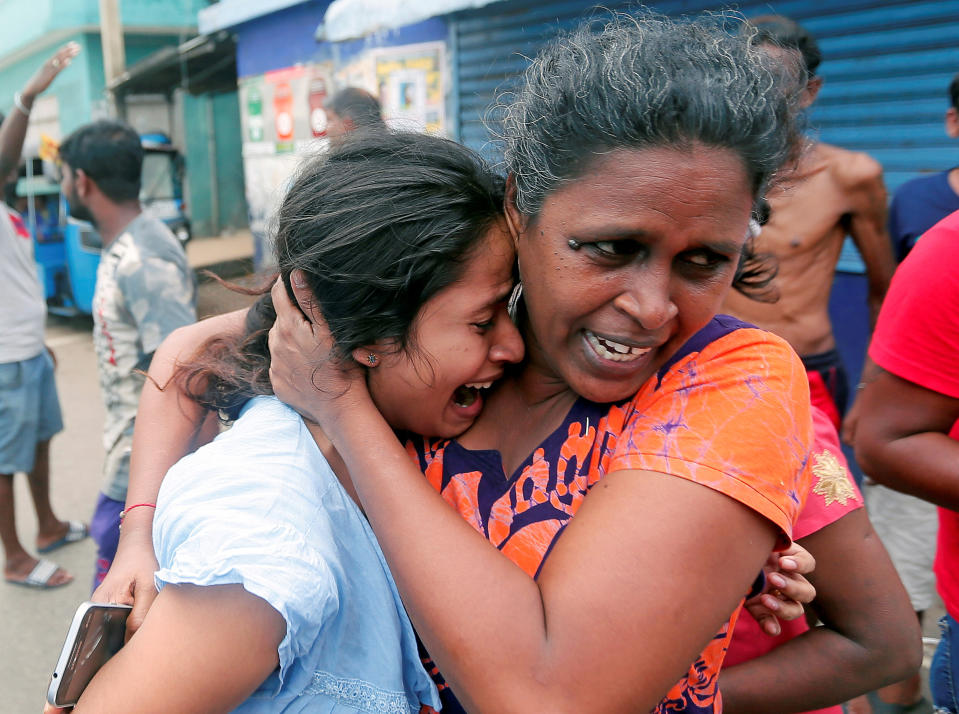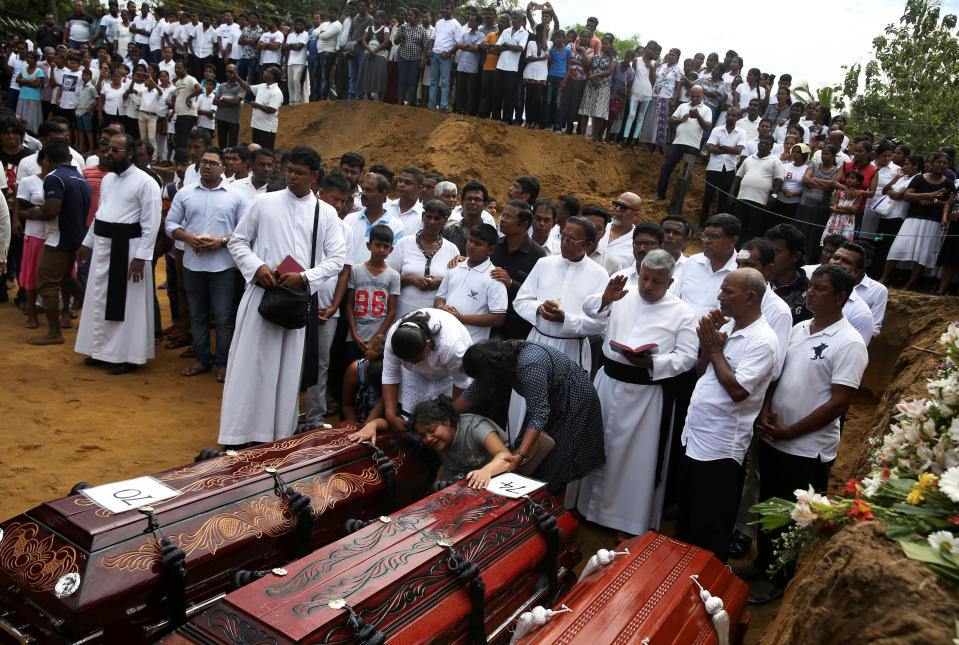ISIS, defeated on the ground, returns to its roots with bombs and bloodshed
When the little-known Islamist group National Thowfeek Jamaath launched a series of suicide-bombing attacks targeting churches and hotels on Easter Sunday in Sri Lanka, triggering one of the deadliest terror attacks since 9/11, many counterterrorism experts suspected the guidance of an unseen hand. The level of coordination and bomb-making sophistication seemed out of reach for a local group with little experience in terrorism.
The riddle was partly solved days later when the propaganda arm of the Islamic State group (ISIS) of Iraq and Syria released photos and video footage of the alleged bombers with an ISIS flag. They were led by Moulvi Zahran Hashim, a local Sri Lankan extremist who has called for the “elimination” of infidels and nonbelievers. One of the Sir Lankan bombers reportedly traveled in 2014 to Raqqa, Syria, the de facto capital of ISIS, where he linked up with ISIS operatives, according to a Wall Street Journal report this week. Three of the other Sri Lanka bombers are reportedly being investigated for travels to Syria, Iraq or Turkey, where they might have come into contact with ISIS bomb experts.
Suspicions of an ISIS connection were further strengthened this week when the group’s leader, Abu Bakr al-Baghdadi, apparently came out of hiding for the first time in five years. In a video released by ISIS, a bearded man claiming to be al-Baghdadi calls the Sri Lanka bombings revenge for the recent loss of the group’s last foothold in Syria. The video, which has not yet been independently confirmed, shows an older, avuncular al-Baghdadi with an AK-47 automatic rifle at his side addressing fellow jihadi soldiers about recent events. In style, tone and content, the video echoes those released by al-Qaida featuring its late leader, Osama bin Laden.

“After months dominated by the narrative that ISIS has been defeated, al-Baghdadi is rallying the troops and trying to compensate for its loss of its caliphate by emphasizing that the group is still expanding,” said Bruce Hoffman, a terrorism expert and senior fellow for counterterrorism and homeland security at the Council on Foreign Relations. In the video, al-Baghdadi talks about receiving new pledges of loyalty from terrorist franchises in Mali and Burkina Faso, and he recognizes by name leaders of ISIS-affiliated groups in Belgium, Australia, Saudi Arabia and Northern Africa.
“Most importantly, he casts the jihad as a battle of attrition that ISIS must prolong to wear down its enemies, which is the exact message that Osama bin Laden conveyed in his last videotape more than a decade ago,” Hoffman told Yahoo News. Al-Baghdadi even styles himself after bin Laden, he notes, sitting with his fighters in combat gear with an automatic rifle. “That’s an image that bin Laden successfully cultivated. Unfortunately, the grievances and conditions that gave rise to al-Qaida and then ISIS are stronger today than ever before, because added to the mix are the visceral emotions of revenge and retaliation for the loss of the ISIS caliphate.”
The global struggle between the West and Islamic-inspired terrorism is a test of wills in which both sides attempt to control the narrative with bombs and carnage. For months, President Trump has touted territorial gains by a U.S.-backed offensive against the ISIS “caliphate” in Syria to claim victory. When ISIS was expelled from its last foothold in the dusty Syrian town of Baghuz in late March, Trump announced once again that the arch-terrorist group had been completely defeated.

The liberation of the caliphate, which once stretched from Syria’s Mediterranean coast nearly to the Iraqi capital of Baghdad, is indeed a watershed moment. Al-Baghdadi’s claim to rule over all Muslims as the “caliph” — announced in a fiery speech at the Al Nuri Grand Mosque in Mosul in 2014 — resonated deeply in the global Islamist movement. At the height of ISIS’s power, it drew more than 40,000 foreign fighters to the group’s black banner and imposed its harsh version of Sharia law over 34,000 square miles of captured territory. Al-Baghdadi drew great power from the narrative of ruling an Islamist homeland, and he is diminished by its collapse.
Yet as the demise of his caliphate loomed in recent months, al-Baghdadi, it now seems clear, was already planning to fall back on terrorist tactics he learned as a lieutenant in the shadowy al-Qaida in Iraq group, seizing the offensive with civilian bombings and mass killings. The perceived success of the Sri Lanka attacks gave him the opportunity.
Joshua Geltzer is a former senior director for counterterrorism on the National Security Council staff, and is now a Future of War Fellow at the New America think tanks. “I do think the Baghdadi tape is an important inflection point, because some triggering event lured him out of hiding after almost five years and made him willing to take the risks of being heard from again,” Geltzer said in an interview. The tape itself, he said, shows that the ISIS leader, whose death has been rumored many times, has survived. “I think it’s because Baghdadi realizes this is a pivotal moment for a group that distinguished itself from other jihadi organizations by owning territory. Baghdadi’s message is that the territory may be gone, but ISIS’s global network has not gone away. Its ability to inspire and perhaps support attacks like the Sri Lanka bombings is intact. So Baghdadi is trying to help ISIS pivot to the next phase.”

U.S. counterterrorism and military officials have always been deeply skeptical of repeated claims by Trump and messaging from the White House that ISIS has been defeated. When Trump announced on Twitter last December that “we have defeated ISIS in Syria” and that he was thus withdrawing all 2,000 U.S. troops from the country, it so shocked Pentagon officials that former Defense Secretary Jim Mattis resigned in protest. Pushback from the U.S. military is evident in the fact that there are still reportedly 1,000 U.S. troops in Syria, and they plan to remain at that level well into 2020
“My takeaway from developing counterterrorism strategy for many years was the need for humility. We populate our strategy since 9/11 with ‘D’ words like ‘defeat,’ ‘destroy’ and ‘deny,’ but words matter,” said Nicholas Rasmussen, the former director of the National Counterterrorism Center, speaking this week at New America’s “Future Security Forum” in Washington. “I would argue for words like ‘manage,’ ‘cope’ and ‘resiliency.’ They don’t soar rhetorically, but unless someone a lot smarter than me can paint a convincing picture of a ‘defeated’ ISIS, I don’t see how we get out of the counterterrorism business in the near term.”
In many ways, ISIS is in a much stronger position to wreak havoc as a traditional terrorist organization today than al-Qaida was in 2002, after its leadership and rank-and-file had been routed from Afghanistan by the U.S. military and its Afghan partners. Al-Qaida, nevertheless, used its remaining command structure and trained fighters to support terrorist spectaculars in the West, including the 2004 Madrid train bombings and 2005 London transport bombings. Al-Qaida also regained much of its strength and influence through its network of far-flung affiliates, many of which continue to terrorize to this day.

The conditions of instability, sectarian conflict and religious extremism that gave rise to al-Qaida and ISIS are even more prevalent today. A recent report by the Task Force on Extremism in Fragile States, for instance, concluded that the number of Salafi-jihadist fighters has more than tripled since Sept. 11, 2001, and there are tens of thousands of radicalized individuals just in Europe. The National Counterterrorism Center’s database of known and suspected terrorists has likewise grown by an order of magnitude over the past 15 years. According to the center, the first two months of this year witnessed more than 200 terrorist attacks in 14 countries, killing or injuring more than 800 people.
Even in that global pantheon of jihadi terrorism, ISIS still stands out for its potency and viciousness. According to U.S. counterterrorism officials, ISIS’s command structure survived the loss of its caliphate in Iraq and Syria, and the group still has an estimated 14,000 fighters in the region, reestablishing a presence through terrorist attacks and assassinations of local tribal leaders. Globally, the group has 20 branches or affiliated networks. Perhaps most worrisome, of the estimated 40,000 foreign fighters who traveled to Iraq and Syria to join ISIS, more than 20,000 are unaccounted for and may have escaped to third countries or returned home, representing a danger of future attacks. Already, more than 100 ISIS foreign fighters have conducted more than 50 terror attacks worldwide, possibly including the Sri Lanka attacks.
“The attack in Sri Lanka was a reminder that the terrorist threat isn’t yesterday’s problem. It hasn’t gone away,” said FBI Director Christopher Wray, speaking recently at the Council on Foreign Relations in Washington, D.C. “Sometimes I think people get a little blasé, and Sri Lanka was a chilling reminder that the threat remains real. And while people are talking about the fall of the ISIS caliphate, there is a virtual caliphate [online] where terrorists can organize without any physical infrastructure.”
In the counterterrorism business, Wray noted, people often refer to the need to “connect the dots” of terrorist plots before they culminate in violence. “But we’re finding that there are fewer people involved in some of these plots, they are taking less time to plan, and they are often using encrypted communications. That means there are fewer dots to connect, and the time law enforcement has to act — what we refer to as the time between ‘flash’ and ‘bang’ — has been compressed and shortened. That has put new strains our law enforcement efforts.”

Russell Travers is the deputy director of the National Counterterrorism Center. “The world has done a great deal to address many aspects of the terrorist threat, and the elimination of the [ISIS] caliphate has, at least temporarily, adversely impacted ISIS ability to orchestrate large-scale external operations,” he said in March, speaking at the World Counter Terror Congress in London. “Nevertheless, we need to avoid premature declarations of victory and certainly need to avoid any sense of complacency.”
Instead, the civilized world, Travers argued, needs to “posture ourselves for a generational struggle against terrorism.”
James Kitfield is a senior fellow at the Center for the Study of the Presidency & Congress.
_____
Read more from Yahoo News:

